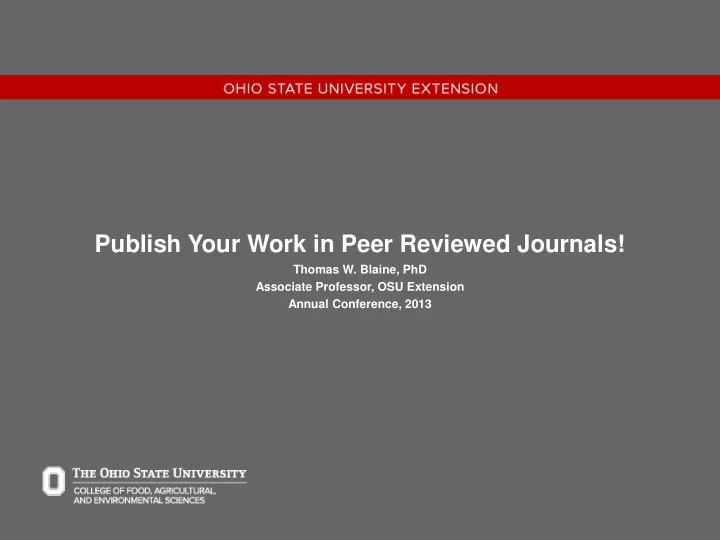

Publish Your Work in Peer Reviewed Journals! Thomas W. Blaine, PhD Associate Professor, OSU Extension Annual Conference, 2013
Extension is a learning organization • Publication lets us share our work beyond Ohio • It lends credibility to the organization, and to you • It provides visibility to your community • It can help you refine your work • It can help you within the organization (promotion) • It can help you cultivate partnerships
Getting started - Make friends with the journals, access is easier now - Pick just one or two journals that publish articles of interest to you, items in your area of work - Include reading over some of these articles as part of your professional development
Identify and overcome the barriers to publication Take advantage of opportunities we have in Extension to getting our work published in a variety of peer reviewed outlets
You will probably find that you are doing some of the things that are discussed in the articles you read But your projects may include some perspectives that are a little different Readers of the journal may be interested Begin thinking about how the work you are doing can build on the existing literature
You are working with colleagues on projects, include them in planning your publication – including reading the literature Co-authorship is the norm, not just in Extension, but in most areas of scholarship – sole authorship is the exception There are some very good reasons for this – why author as a team?
Because (a) different members of the team bring different kinds of expertise and (b) they push each other. Both of these tendencies improve results.
Think of potential articles in one of two categories: Conceptual – ideas that you have, procedures, descriptions of programs Empirical – data driven (surveys, statistics)
As you write: Cite sources, especially from the journal to which you plan to submit Citing sources: a) gives credit where credit is due b) shows you are building on existing literature c) demonstrates your integrity
As you write: Follow author guidelines, especially for submission type (article category) Mimic the style of presentation of articles you have read, and follow other norms for the journal to which you are submitting
As you write: Use subheadings – they help keep the paper organized and improve the flow Avoid: “Monster paragraphs” Run-on sentences
As you write: Make sure you have one “official” latest version of the manuscript - number if necessary This will ensure that all revisions get incorporated Make sure co-authors know whose court the ball is in
As you write: Be sure to use two very important presentation tools 1) Tables and 2) Figures Both of these tools will help reviewers and readers follow you – and in some journals they do not count against word limits
As you write: Refer to tables and figures in the text – usually right before the presentation of each You may interpret the information you present in tables/figures in the text, but try to minimize repetition
As you write: One place where repetition is okay: implications of your work You must make the case for publication – why is your manuscript of interest to the readership? This emphasis should be in the Introduction and Conclusion
Responding to reviews: Include in your resubmission letter a response to each comment you received Do not leave any comment out Be specific and thorough
Responding to reviews: Organize your resubmission letter by order of reviewer comment If a reviewer asks you to change something and you are convinced the change is wrong:
Responding to reviews: Explain carefully in your letter Cite references if they help you make your case You will probably find that most reviewer suggestions are helpful, even if they mean more work
Responding to reviews: Try not to take harsh reviews personally Most of the time the reviews are anonymous Many times thorough reviews will help you produce your best work!
Good luck! Web help: http://library.osu.edu www.joe.org
Recommend
More recommend